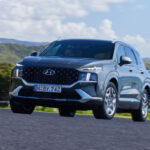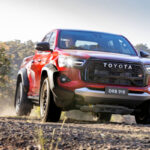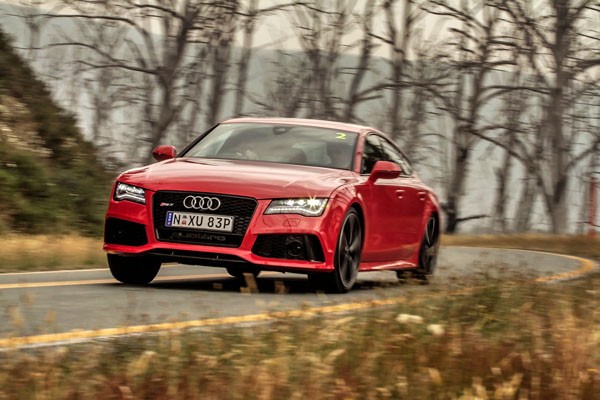
In the words of the song: ’Nobody does it better’ the Germans are past masters at producing prestige vehicles with a sporting bent. Audi is no exception, with its RS 7 Sportback heading a group of ‘good sports’ with an impeccable pedigree.
Prestige comes at a price – the RS 7 Sportback costs $238,500 plus on-road costs. And in the case of the test car a suite of options that pushed the price up to $265,590.
Top of the luxo league, oddly, was the $12,000 Bang and Olufsen advanced sound system putting out more than 1200 Watts of power through no fewer than 15 speakers.
Adaptive cruise control, lane assist, side assist and pre-sense plus; a dynamic driving package and night vision assist make up the rest of dollar dazzlers, while the test car included 21-inch high gloss black alloy wheels and body coloured exterior mirrors at no extra cost.
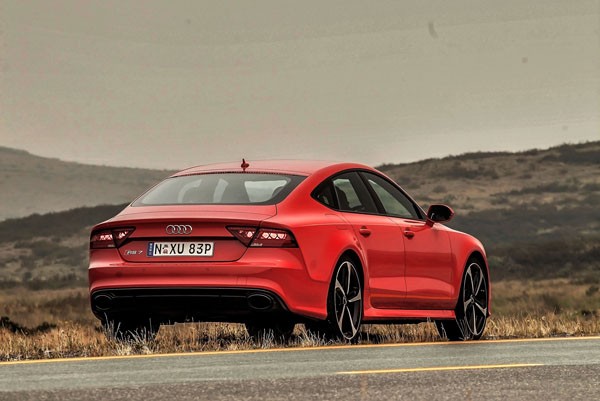
STYLING
With classic coupe styling credentials, the big four-door saloon is able to stand its ground among any number of impeccably dressed blue bloods. Chopped off rear-end with boot spoiler lip, distinctive bumpers, partly tinted LED headlights, high-gloss black honeycomb radiator grille and flared sills shout Sportback.
Standard equipment includes power adjustable heated RS sport front seats with substantial side bolsters, integrated head restraints, pull-out cushions and embossed RS 7 logos.
In the back are two individual sculpted sports seats with integrated head restraints. While leg room in the back is limo-like, head room is not so, with the roof dipping towards the sleek yet rounded rear.
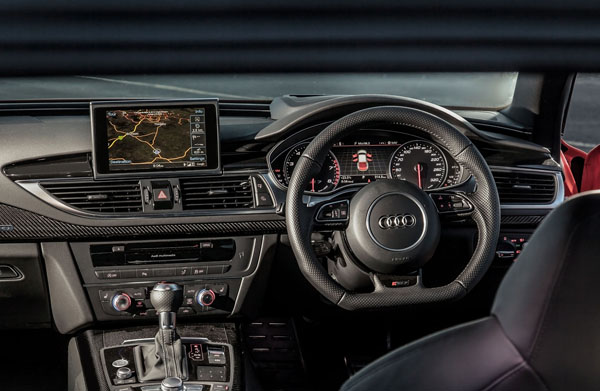
An electrically operated boot lid gives convenient access to 535 litres of luggage space which can be expanded to a massive 1390 litres by folding down the split rear seat backs. Straight side walls and flat floor make almost every centimetre usable.
INFOTAINMENT
The standard MMI navigation plus includes a retractable, high-resolution, 8-inch monitor, touchpad control, 60 GB hard drive, DVD drive and voice control.
Audi connect plus car phone, supplements MMI navigation plus, letting passengers surf and e-mail freely. It delivers tailored Internet services from Audi connect to the car, including navigation with the Google Earth maps service and Google Street View.
ENGINE / TRANSMISSION
Producing 412 kW and 700 Nm, the 4.0 direct-injection twin-turbo V8 features an innovative design, with the exhaust and turbochargers sitting inside the ‘V’, and intakes to the outside of the engine. Greater thermal efficiency of this layout makes for better fuel efficiency and lower emissions.
An eight-speed Tiptronic automatic transmission has been matched to engine performance, with drivers able to choose between Drive and Sport modes, or take over changes themselves, via gearshift lever or steering wheel-mounted paddles, with the help of a rev limit warning light on the driver info display.
Quattro permanent all-wheel drive divvies up power between the front and rear axles, from 40 per cent front, 60 per cent rear, under normal conditions to give optimum grip when these change. Audi also offers a sport differential, which distributes power between the rear wheels to limit understeer or oversteer on bends.
The test car came up with fuel consumption figures of 7.6 litres per 100 kilometres in motorway cruising and something north of 10 litres per 100 kilometres in under-speed town traffic.
SAFETY
As in a jet airliner, safety of passengers largely goes beyond the pilot (driver) with a range of systems including adaptive cruise control, side assist and active lane assist, park assist and night vision. Head-up display also projects information onto the windscreen directly in front of the driver.
DRIVING
A special mention must be made of Audi Drive Select which enables the driver to choose how the car travels by altering steering, engine management, the Tiptronic and the sport differential. Modes available are Comfort, Auto, Dynamic and Custom.
In Dynamic mode the stirring engine note is modulated by sound flaps in the RS exhaust system controlled independently from engine load and speed, and the eight-speed Tiptronic’s operating mode. An RS sport exhaust system with black tailpipe tips and an even more distinctive sound is available as an option.
With all systems ‘on song’ the Audi RS 7 Sportback can be reconfigured to conform to a wide range of road conditions and driving styles, or can be left to maintain optimum ride and handling.
Steering is responsive and provides sufficient driver feedback. Brakes are firm to sharp.
Road noise intrudes into the cabin on coarser surfaces but usually not enough to upset travellers’ conversation.
SUMMING UP
The Audi RS 7 Sportback allows up to four companions to enjoy a rare driving experience in the lap of luxury.
AT A GLANCE
MODEL RANGE
Audi RS 7 Sportback 4.0 TFSI quattro Tiptronic $238,500 (as tested, $265,590)
Note: This price does not include government or dealer delivery charges. Contact your local Audi dealer for drive away prices.
FEATURES
Adaptive air suspension (Sport)
LED headlights with high-beam assist
Digital TV reception with DAB plus
quattro sports differential
RS sports exhaust
Head-up display
21-inch alloy wheels in five-spoke blade design in matt titanium look, high gloss turned finish
Audi parking system plus with front and rear cameras
Glass sunroof
RS sports seats upholstered in Valcona leather and honeycomb stitching
Matt aluminium styling package including funnel-shaped lower air intake with quattro logo
SPECIFICATIONS (Audi RS 7 4.0 TFSI petrol engine))
Capacity: 3993 cc
Configuration: V8 spark-ignition engine with aluminium engine block and gasoline direct injection, DOHC, exhaust turbocharger, two charge movement flaps, demand-controlled high pressure and low pressure fuel system, cylinder on demand, indirect intercooler. Start / stop system
Bore x Stroke: 84.5 mm x 89 mm
Compression Ratio: 10.0:1
Maximum Power: 412 kW @ 5700-6600 rpm
Maximum Torque: 700 Nm @ 1750-5500 rpm
DRIVELINE:
Transmission: 8-speed Tiptronic with DSP and sport program, hydraulic torque converter with lock-up clutch, quattro permanent all-wheel drive with self-locking centre differential
DIMENSIONS, WEIGHT AND CAPACITIES:
Length: 5012 mm
Width: 1911 mm
Height: 1419 mm
Wheelbase: 2915 mm
Track: 1634 mm (front); 1625 mm (rear)
Kerb weight: 1920 kg
Gross weight limit: 2505 kg
Roof load limit: 100 kg
Cargo capacity: 535 litres; 1390 litres (rear seat folded)
Fuel Tank Capacity: 75 litres
Towing capacity: N/A
Turning circle: 11.9 m
Drag co-efficient: Cd 0.30
SUSPENSION AND BRAKES:
Suspension: Five-link, double upper and lower wishbones, anti-roll bar, air suspension / suspension with Dynamic Ride Control (front). Self-tracking trapezoidal-link axle with wishbone, anti-roll bar, air suspension / suspension with Dynamic Ride Control (rear)
Brakes: Dual-circuit with diagonal split, electronic stabilisation control
(ESC), brake servo, hydraulic brake assist; front: ventilated discs, fixed
callipers; rear: ventilated discs, fixed callipers with electromechanical parking
brake
Steering: Electromechanical steering with speed-dependent power assistance
Wheels: Cast aluminium wheel 9×21, offset 35
Tyres: 275/30 R21 98Y XL
PERFORMANCE
Acceleration 0 to 100 km/h: 3.9 sec
Top speed: 250 km/h (280 km/h optional)
FUEL CONSUMPTION:
Fuel type: Super Plus sulphur-free according to DIN EN 228 / 98/95 RON
Combined Cycle (ADR 81/01): 9.8 litres per 100 km. CO2 emissions 229 g / km
Emissions: Euro V
GREEN VEHICLE GUIDE RATINGS:
Greenhouse Rating: 5.0 / 10
Air Pollution Rating: 7.5 / 10
STANDARD WARRANTY:
3 years / unlimited kilometres





